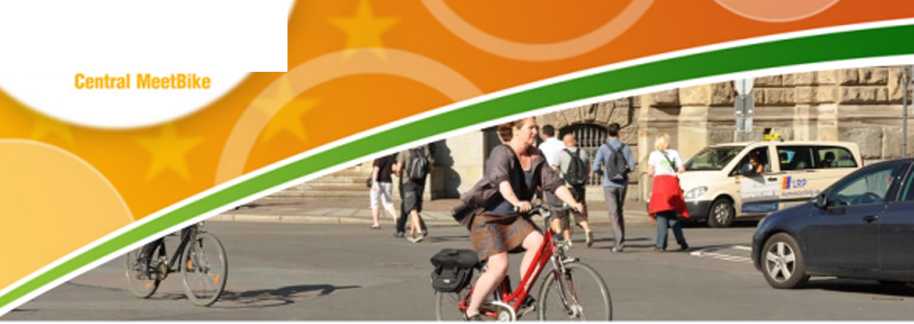9220598008
SCM<^

Fact Sheet H-01 - Developing a Cycling Network and General
Design Standards for Bicycle Infrastructure
Network planning
Bicycle network planning is a vital part of devetoping a bicycle transport strat-egy. The bicycle network is an element ot a city's comprehensive mobility plan and takes into consideration the con-nectivity ot vanous activity centres (e.g. residential. education. jobs. public transit. shopping etc.) in order to promote destination-oriented daily cycling. As an element of an integrated (bicycle) transport strategy. the bicycle network is part of supply-oriented planning and needs to support the goals developed by the municipality and stakeholders as laid out in the strategy. It should encou-rage cycling demand.
After preliminary considerations as to the planning area and the origins and destinations of potential cyclists (the activity centres listed above). an analy-sis of the current Street network can be completed. This indudes documenting:
• Ouality of existing streets and intersections along with planned changes
• Current demand on roads and intersections (from traffic counts)
• Traffic volumes along origin-destination relationships Routes between origins and destinations should be developed primarily along existing network elements. for example through speed 30 zones or along roads with existing facilities or recreational cyde paths independent of streets. By comparing the preferential network of destinations and origins with the analysis ot the existing network. gaps and areas for improvement can be determined.
For the comparison (and cycling strategy in generał) it is useful to break the network down into hierarchical catego-ries based on function. The functional categories determine desired cydist speeds and the maximum acceptable delay due to cyclists having to stop and wait. An urban cyding network can ge-nerally be dńrided into three categories. which can be found in Table 1.
The route fundion relates to what is being conneded and not to the type of cyde fadlity that should be provided. For example. a main bicycle route in a speed 30 zonę will still allow cyclists to ride at 15-20 km/h and at the same time not require cyclists to stop and wait at traffic lights.
However for safety reasons. cycle facilities should be available along all main streets. regardless of their role in the bicycle network. The fadors influ-endng choree ot facility type are dis-cussed in Fact Sheets H-02 and H-03.
Network hierarchy
The function of main bicycle routes in generał is to provide connections between all major adivity centres (in-cluding residential. education. job. shopping. transit centres etc.) in an urban area. These routes provide the base form ot the cycle network. If these routes run along main streets. bicycle fadlities are either off-carriageway. e.g. as bicyde paths parallel to the carria-geway. or in the form of bicyde lanes. which have been shown. through re-search and crash analyses sińce the 1980s. to provide a higher level of safety and comfort. It should be em-
|
Category |
Connects |
Oeslred rldlng speeds (km/h) |
Resultlng max. acceptable delay due to stopplng and waltlng |
|
mam bicycle routes |
mam centre-mtermediate centre |
15-20 |
45 s |
|
(high-speed Imks) |
mtermediate centre-mtermediate centre |
(up to 25) |
(30 s) |
|
secondary bicycle roules |
mtermediate centre-neighbourhood centre neighbourhood centre-neighbourhood centre |
15-20 |
60 s |
|
local roules |
- |
- |
- |
Tabte 1: Route hierarchy and characteristics (based on FGSV (2010) p.10)

Wyszukiwarka
Podobne podstrony:
CMbii^Central MeetBikelFact Sheet H-06 - Rural Cycling (daily and leisure routes) Necessity of rural
Fact Sheet S-01 - General Recommendations for Public Relations Introduction Actors in public relatio
• Spis treści •Wojciech Huszlak General and sector standards for social and ecological reporting (Og
Fact Sheet H-04 - Intersections Particular relevance of intersections Designing and planning interse
Fact Sheet H-02 - Cycling Facilities on the RoadOverview Street space is a limited resource. The pro
Fact Sheet T-03 - Options for financing measures for Cycling Introduction building 300 m of a cyde
C. To determine the importance of the detailed geomorphological map for the development of geomorpho
milo 01 09 Fiutrac* 5 f left
milo 01 18 thc shoulder. and thc big back muscle known as thc latissimus dorsi musdc which oyerlays&
nanostructure41995s Particles Shell Cavities Networks and pores Ąncj p0Wders Bulk Planar surface Sph
Folia Medica Lodziensia, 2011, 38:215-225Estimation of Cyclin E expression and its possible prognost
• Członek komitetu programowego DYNAS 2010 - Dynamie Networks and Security 2010
CONTENT Stage 1 - Outcome 2 Describe the characteristics of Computer networks and internetworks 1.1
The following apply to all types of network both local area networks and wide area networks, m both
Integrated system for sports - a concept embedded... 81 certain morę developmental systems, platform
Ulmus laevis big This distributiort map was compiled by members ofthe EUFORGEN Noble Hardwoods NetWo
więcej podobnych podstron